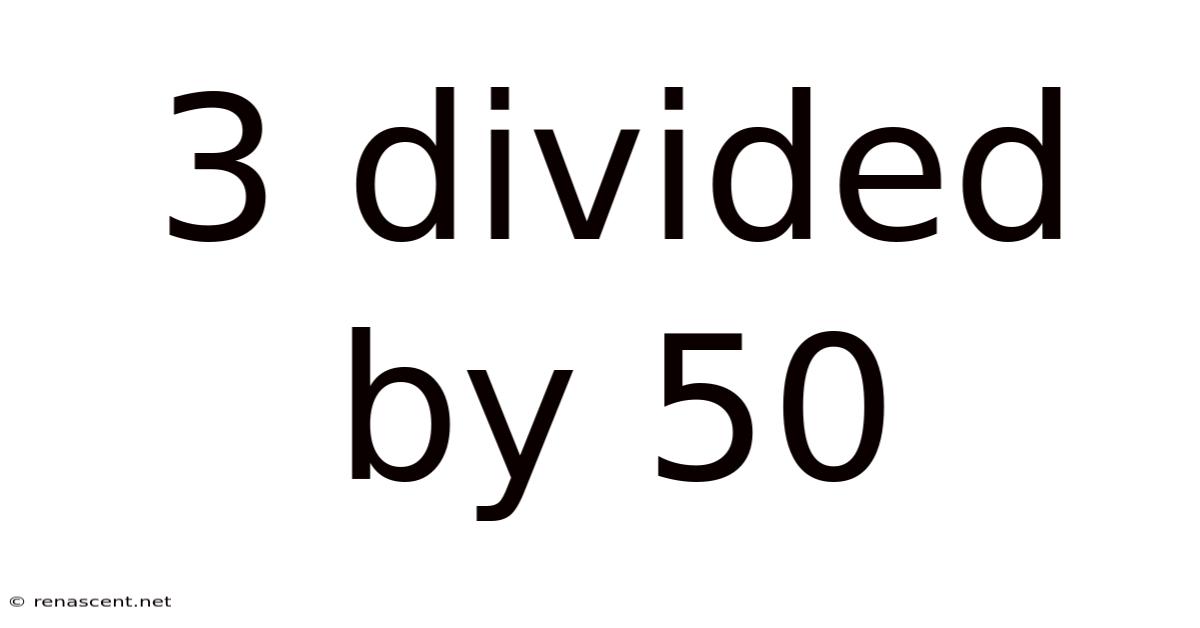3 Divided By 50
renascent
Sep 16, 2025 · 5 min read

Table of Contents
3 Divided by 50: A Deep Dive into Decimal Division
Understanding division, especially when dealing with decimals, is a fundamental skill in mathematics. This article will explore the seemingly simple calculation of 3 divided by 50, breaking down the process step-by-step and delving into the underlying mathematical principles. We'll cover various methods of solving this problem, discuss the significance of decimal representation, and even explore some real-world applications. By the end, you'll not only know the answer but also possess a deeper understanding of decimal division and its broader implications.
Understanding the Problem: 3 ÷ 50
At its core, the problem "3 divided by 50" (3 ÷ 50) asks: how many times does 50 fit into 3? Intuitively, we know that 50 is larger than 3, meaning that 50 doesn't fit into 3 even once. This leads us to the realm of decimal numbers, where we'll find a fractional answer. This seemingly simple problem provides a great opportunity to explore several essential mathematical concepts.
Method 1: Long Division
The traditional method of solving this is through long division. While this might seem tedious for a simple problem, it's crucial for understanding the fundamental process and building a solid foundation for more complex division problems.
-
Set up the division: Write the problem as 3 ÷ 50, or as a fraction: 3/50.
-
Add a decimal point and zeros: Since 50 doesn't go into 3, add a decimal point to the 3 and add zeros as needed. This allows us to continue the division process. We can write it as 3.000 ÷ 50.
-
Perform the division:
- 50 does not go into 3.
- 50 does not go into 30.
- 50 goes into 300 six times (6 x 50 = 300). Write 0.06 above the decimal point.
- Subtract 300 from 300, leaving a remainder of 0.
-
The answer: The result of 3 ÷ 50 using long division is 0.06.
Method 2: Converting to a Fraction
Fractions provide another effective method for solving this division problem. Converting the division problem into a fraction allows us to simplify and find the equivalent decimal value.
-
Write as a fraction: Represent 3 ÷ 50 as the fraction 3/50.
-
Simplify the fraction (if possible): In this case, the fraction 3/50 is already in its simplest form because 3 and 50 do not share any common factors other than 1.
-
Convert to a decimal: To convert the fraction 3/50 to a decimal, we can perform the division: 3 divided by 50. This gives us the same answer as the long division method: 0.06.
Method 3: Using a Calculator
The easiest method, particularly for more complex division problems, is to use a calculator. Simply input "3 ÷ 50" into a calculator, and it will instantly provide the answer: 0.06. While convenient, understanding the underlying mathematical principles remains crucial for problem-solving proficiency.
Understanding the Decimal Result: 0.06
The answer, 0.06, represents six hundredths. This is a decimal fraction, where the digits to the right of the decimal point represent fractions of a whole. In this case, 0.06 is equivalent to 6/100, which can be further simplified to 3/50, bringing us back to our original fraction.
Real-World Applications
While seemingly simple, the concept of dividing 3 by 50 has numerous real-world applications. Here are a few examples:
-
Calculating percentages: If you scored 3 points out of a possible 50, your score is 0.06 or 6%. This is a fundamental application in many areas like academics, finance, and statistics.
-
Dividing resources: Imagine you have 3 liters of juice to share equally among 50 people. Each person would receive 0.06 liters of juice.
-
Scaling recipes: If a recipe calls for 50 grams of an ingredient, but you only have 3 grams, you could use 0.06 of the recipe's quantities for the other ingredients.
Frequently Asked Questions (FAQ)
-
Q: Can 3 be divided by 50 without using decimals? A: No, because 50 is larger than 3. The result will always be a fraction or a decimal less than 1.
-
Q: What is the remainder when 3 is divided by 50? A: When using long division, the remainder is 0. This indicates that the division is exact, resulting in a terminating decimal.
-
Q: How can I check my answer? A: You can multiply the answer (0.06) by 50. If you get 3, your answer is correct.
Expanding Our Understanding: Decimal Division and Beyond
The seemingly simple calculation of 3 divided by 50 provides a gateway to a much broader understanding of decimal division, fractions, and their application in the real world. It emphasizes the importance of understanding fundamental mathematical concepts and their practical applications.
By mastering this concept, you build a strong foundation for more complex mathematical operations, including working with larger numbers, more complex fractions, and even venturing into algebra and calculus. The ability to confidently navigate decimal division is not just a mathematical skill but a valuable asset in various aspects of life. It's a skill that fosters critical thinking, problem-solving capabilities, and a deeper appreciation for the elegance and practicality of mathematics. Remember, a strong understanding of basic mathematical principles is the cornerstone of success in more advanced areas of mathematical study. So, keep practicing, keep exploring, and keep expanding your mathematical knowledge!
Latest Posts
Latest Posts
-
Weight Of A Potato
Sep 16, 2025
-
2000 Divided By 5
Sep 16, 2025
-
1 7 Kilograms To Pounds
Sep 16, 2025
-
What Is 8 8
Sep 16, 2025
-
16 9 Oz To Ml
Sep 16, 2025
Related Post
Thank you for visiting our website which covers about 3 Divided By 50 . We hope the information provided has been useful to you. Feel free to contact us if you have any questions or need further assistance. See you next time and don't miss to bookmark.